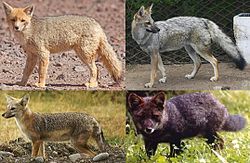| Lycalopex [1] | |
|---|---|
 | |
| Scientific classification | |
| Kingdom: | Animalia |
| Phylum: | Chordata |
| Class: | Mammalia |
| Order: | Carnivora |
| Suborder: | Caniformia |
| Family: | Canidae |
| Subfamily: | Caninae |
| Tribe: | Canini |
| Subtribe: | Cerdocyonina |
| Genus: | Lycalopex Burmeister 1854 |
| Type species | |
| Canis magellanicus [2] | |
| Species | |
 | |
| Range of the six living zorro species | |
| Synonyms | |
| |
The South American foxes (Lycalopex), commonly called raposa in Portuguese, or zorro in Spanish, are a genus inhabiting South America. Despite their name, they are not true foxes, but are a unique canid genus more closely related to wolves and jackals than to true foxes; some of them resemble foxes due to convergent evolution. The South American gray fox, Lycalopex griseus, is the most common species, and is known for its large ears and a highly marketable, russet-fringed pelt.
Contents
The second-oldest known fossils belonging to the genus were discovered in Chile, and date from 2.0 to 2.5 million years ago, in the mid- to late Pliocene. [4] The Vorohué Formation of Argentina has provided older fossils, dating to the Uquian to Ensenadan (Late Pliocene). [5]















